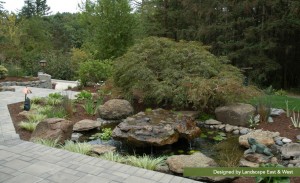5 Reasons to Build a Rain Garden
 The Pacific Northwest, particularly west of the Cascades, becomes a very soggy place in the winter. And as last winter’s heavy, cold La Nina rains proved, only so much water can be soaked up by standard landscaping. Portland, Oregon residents are catching on to the idea that a rain garden can help offset our region’s heavy precipitation.
The Pacific Northwest, particularly west of the Cascades, becomes a very soggy place in the winter. And as last winter’s heavy, cold La Nina rains proved, only so much water can be soaked up by standard landscaping. Portland, Oregon residents are catching on to the idea that a rain garden can help offset our region’s heavy precipitation.
Just what is a rain garden, you ask? Well, rain garden designs are meant to soak up extra water after storms. When creating rain garden designs, landscape designers select plants whose roots love to be periodically submerged in water. (Native bog and riparian species fit the bill nicely.) Additionally, a rain garden is often dug into the surrounding earth so as to create a lower area where water will naturally pool. The overall idea is that precipitation will collect in the rain garden and slowly drain out through the underlying soil, rather than quickly rushing down city streets and gutters.
The main achievement of rain garden designs, then, is that they hold onto water until it can drain slowly away. This kind of local water management offers several big benefits, including:
1. Protection from floods.
A rain garden creates a safe place where floodwaters can pool and slowly drain away, rather than rush into your home or outbuildings. Rain garden designs include a thorough consideration of where nearby buildings are located and how water will naturally tend to flow through the property. Concrete or stone walls, mounds and other vertical rain garden elements help direct water toward the garden, keeping it away from valuable property.
Collectively, the more rain gardens a city has, the more water its soil will be able to hold and the less water that will rush straight through city streets and storm drains.
2. Protection for local watersheds.
It is estimated that as much as 70 percent of all pollution in America’s standing waters comes from rainwater runoff. When water runs down city roofs and streets, it picks up automobile fluids, road salt, animal waste, pesticides and other pollutants. Without the slowing mechanism of rain gardens, these pollutants run directly into nearby rivers and streams. By contrast, the process of filtering down through a rain garden naturally cleans the water and filters out pollutants. In this way, a rain garden helps ensure clean, healthy water for your community.
3. Increased property value.
The aesthetic and utilitarian benefits of a rain garden can attract potential homebuyers to your home and landscaping. Portland, Oregon is a popular relocation city these days. If you’re thinking of selling your home, a rain garden can contribute to your home’s resale value. Because they add the beauty of a Zen retreat, rain gardens often increase curb appeal as well as property values.
4. Lower pest populations.
Because they help water drain more quickly, rain garden designs actually reduce mosquito populations. To breed, mosquitoes require standing water in landscaping. Portland, Oregon rain gardens typically hold water for only a few hours – too short a time for mosquitoes to lay their eggs. Rain gardens also attract native birds and bats to help keep pest populations in check.
5. A reason to love the rain.
Let’s face it: Those five or six months of daily rain can get anyone down. Especially for those who move to Portland or Seattle from dryer, sunnier climes, the Pacific Northwest can be a depressing place during the rainy months. Adding a rain garden will give you the chance to enjoy the wildlife and amazing range of plant species that our mild, moist Pacific Northwest climate can sustain. With a rain garden in your backyard, you’re more likely to see the seasonal rains as a good thing, because they nourish your lush garden retreat.
